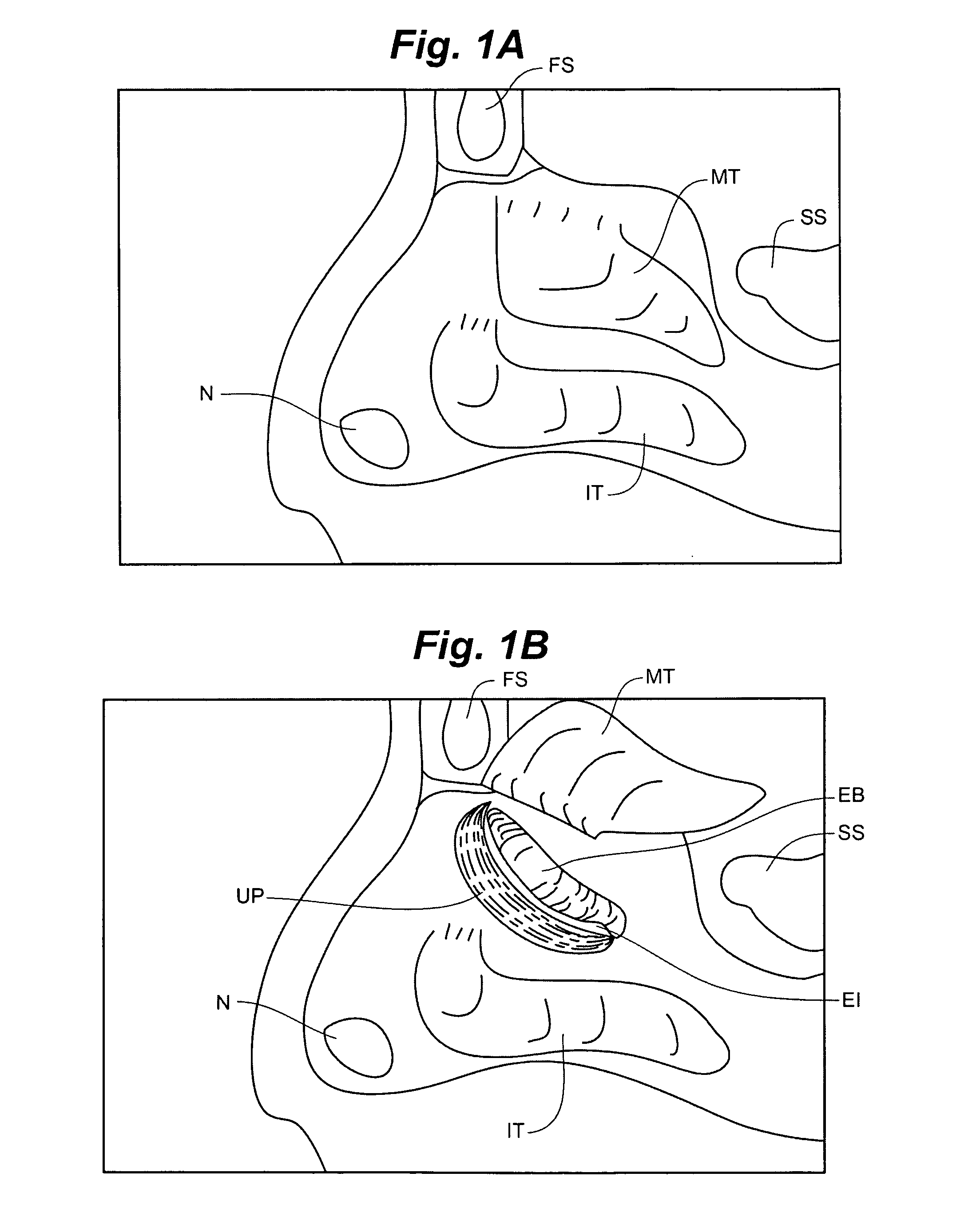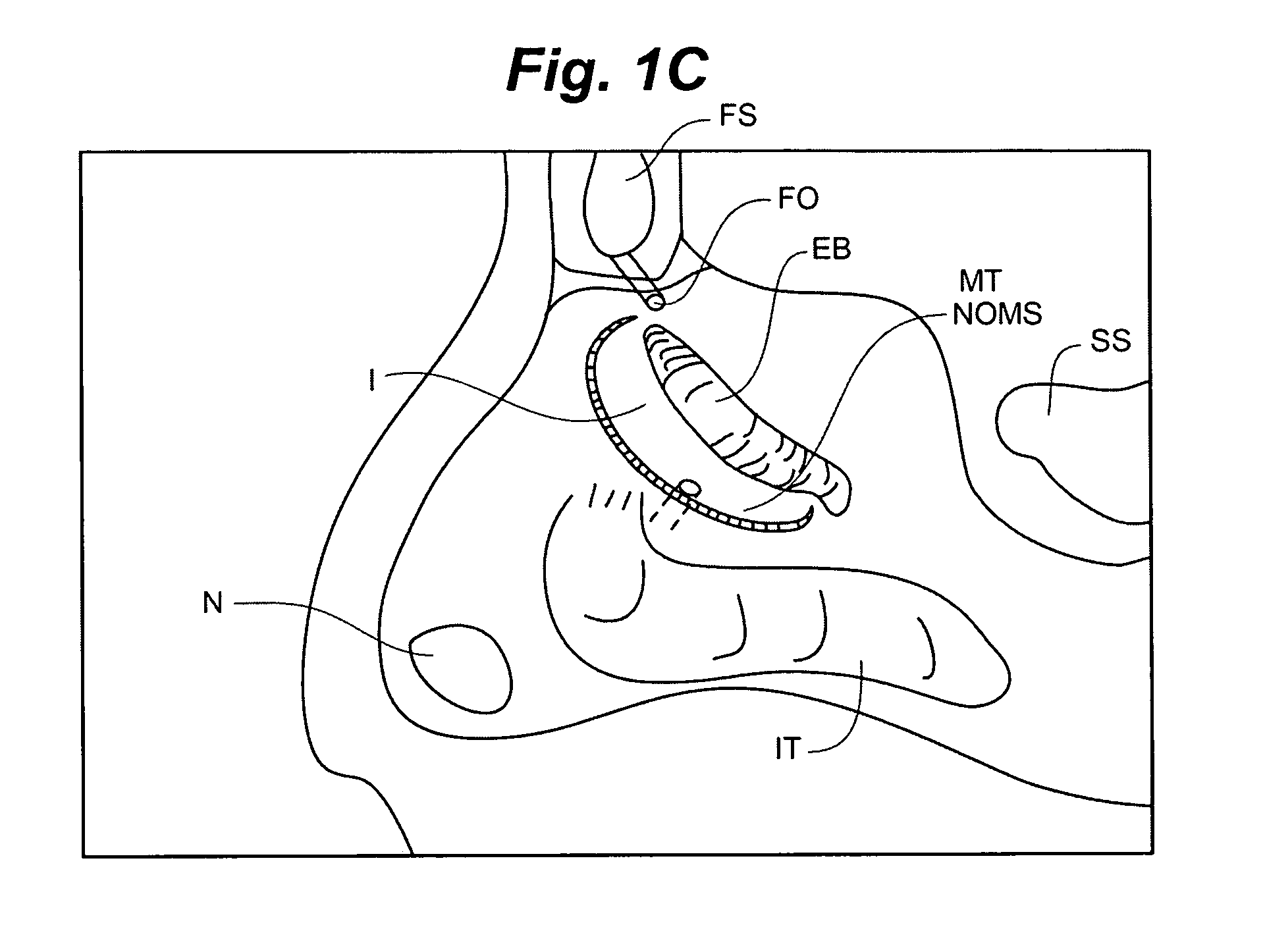Devices and methods for minimally invasive access to sinuses and treatment of sinusitis
a technology of sinuses and minimally invasive access, applied in the field of sinuses and sinusitis treatment, can solve the problems of difficult to execute atraumatically, cumbersome x-ray fluoroscopy and transillumination, and difficulty in advancing to the infundibulum, so as to facilitate broad application, facilitate broad application, and facilitate the effect of learning and execution
- Summary
- Abstract
- Description
- Claims
- Application Information
AI Technical Summary
Benefits of technology
Problems solved by technology
Method used
Image
Examples
first embodiment
[0176]FIG. 42A shows the drug delivery device of the present invention, consisting of a drug containing matrix (120) with an embedded degradable framework (121). The framework (121) is anchored by a spine (122) that follows the axis of the ellipsoid matrix. A series of ribs (123) protrude radially from the spine. Coplanar ribs (123) are depicted here as three in number, but could be more; ideally, no less than three would occupy a single transverse plane of the ellipsoid. Alternatively, the ribs (123) could stack in a spiral. The tip (124) of each rib would ideally protrude just past the surface of the matrix (120) in the nondegraded state. A cross-sectional view of the framework (121) is shown in FIG. 42B. As engineered, the framework (121) should degrade more slowly than the matrix (120) revealing more and more of the ribs (123). Thus, as the matrix resorbs and grows smaller, the retention device remains intact. The tips (124) of the ribs remain in contact with the sinus mucosa, b...
second embodiment
[0177]FIG. 43A shows the drug delivery device of the present invention. FIG. 43B shows a cross-sectional view. The drug delivery device comprises a matrix (130) and an embedded degradable framework (131) design. In addition, this framework (131) is also anchored by a coaxial spine (132). Distinct from the embodiment depicted in FIG. 42A, however, is an expansile “umbrella” of ribs (133) also attached radially to the spine (132); here the attachment is outside the matrix (130) at one apex. The umbrella (134) is collapsed around the surface of the matrix (130) within the receptacle (see FIGS. 38 and 39) of the insertion device. As shown in FIG. 43C (and cross-sectional view FIG. 43D), the umbrella (134) then expands upon extrusion into the sinus. The retention and degradation properties of the drug delivery device are similar to those outlined in the discussion of the embodiment illustrated in FIG. 42A.
third embodiment
[0178]FIG. 44A shows the drug delivery device of the present invention. FIG. 44B shows a cross-sectional view. The drug delivery device shares with the earlier embodiments the matrix (140) and embedded degradable framework (141) design. It, too, can be anchored by a coaxial spine (142), though this is not strictly necessary. Here, the matrix is surrounded at its surface by a cage (143) that is embedded in but projects just above the surface of the matrix (140) to enhance its retention properties at the outset. As the matrix (140) degrades, it remains within the confines of the cage (143) until the matrix (140) fragments become small enough to extrude through the openings in the cage (143). Other retention and degradation properties are similar to those outlined above.
Benefits of The Present Invention
[0179]Unique to the present invention, the combination of the minimally invasive anterior keyhole approach, the described guide-free drug placement devices, and the absence of any retain...
PUM
 Login to View More
Login to View More Abstract
Description
Claims
Application Information
 Login to View More
Login to View More - R&D
- Intellectual Property
- Life Sciences
- Materials
- Tech Scout
- Unparalleled Data Quality
- Higher Quality Content
- 60% Fewer Hallucinations
Browse by: Latest US Patents, China's latest patents, Technical Efficacy Thesaurus, Application Domain, Technology Topic, Popular Technical Reports.
© 2025 PatSnap. All rights reserved.Legal|Privacy policy|Modern Slavery Act Transparency Statement|Sitemap|About US| Contact US: help@patsnap.com



